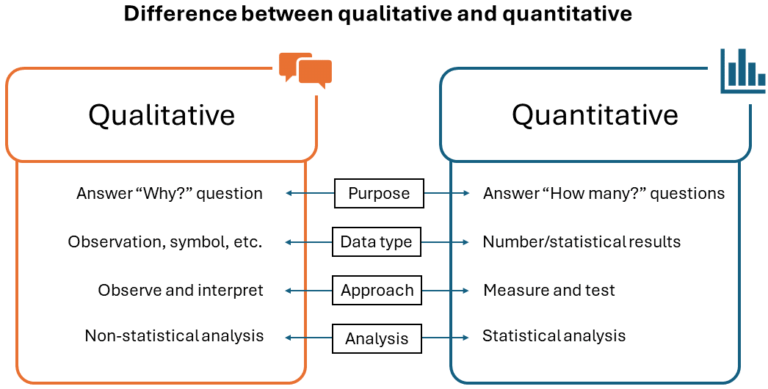Methodology is part of the series on how to write your dissertation and it typically comes after the introduction and literature review, and before the results and conclusion. This guide provides an overview on how to write a methodology chapter
When creating a methodology for research findings, it is vital to have a comprehensive and detailed description of the process used to support your conclusions. This includes outlining the techniques employed and providing a clear explanation of how the results were obtained. Furthermore, a well-written methodology should not only outline the methods used but also provide a rationale for why they were chosen.
In this article, we provide an overview of the steps required to effectively write a methodology, share valuable advice for crafting a methodology, and address common queries surrounding the methodology writing process.
1. Why is a methodology chapter important?
The methods section is a crucial component of your research paper, as it provides a detailed account of the methods and techniques used to conduct your study. It demonstrates the rigor and validity of your research, and justifies the choices you made in terms of data collection and analysis. By including a thorough methods section, you are not only providing transparency and accountability, but also making it possible for others to replicate your study. Additionally, it positions your research within the broader context of your field, and serves as a reference point for readers who may have questions or concerns about the methodology.

1.1 Restating your research problem
Your methodology should clearly and succinctly restate the problem being investigated and provide context for the reader. This helps guide them through your research process and ensures they understand the assumptions and variables being examined. Additionally, restating the thesis allows for a review of any potential limitations in the research.
After clearly restating the research problem, it’s important to explain the type of research method used in your study. Clearly articulate the rationale behind your choice, whether it be qualitative, quantitative, or a blended approach. If applicable, explain any alternative methods specific to your field that were considered and why they were ultimately chosen or not chosen. This helps the reader understand the methodology and the choices made, and also provides context for the results obtained.
Clarify any unusual methods used in your research by stating the reason for their use. Provide evidence for the validity of your findings by explaining how your unique approach or adaptation of a process from another field is specific to your thesis topic. This helps to address potential criticisms of your methodology.
1.2 Describe how you collected the data
In your research report, specify the type of data used (i.e. quantitative or qualitative). Clearly outline the details of any experiments conducted, including the design, methods for measuring variables, and tools used. Provide information on the sourcing of existing data, including the original method of data collection and the criteria used to select data from other sources.
Qualitative methods
Qualitative methods in a dissertation methodology chapter involve the collection and analysis of non-numerical data, such as observations, interviews, and written or visual materials. The goal of qualitative research is to understand a phenomenon from the participants’ perspective.
Some common qualitative methods used in dissertations include:
- Interviews: one-on-one or group conversations with participants to gather information about their experiences, thoughts, and opinions on the research topic.
- Observations: systematic observation of participants in their natural setting to gather information about their behavior and interactions.
- Document analysis: examination of written or visual materials, such as texts, photographs, and videos, to gather information about the research topic.
- Case study: an in-depth examination of one or a few specific cases, such as individuals, organizations, or events, to understand a phenomenon in a particular context.
In the methodology chapter, it’s important to explain the rationale for using qualitative methods, how the data was collected, how the data was analyzed, and the steps taken to ensure the credibility and rigor of the study.

Quantitative methods
Quantitative methods in a dissertation methodology chapter involve the collection and analysis of numerical data, such as statistics and measurements, in order to test hypotheses and make inferences about a population. The goal of quantitative research is to establish cause-and-effect relationships and to make generalizations about a population from a sample.
Some common quantitative methods used in dissertations include:
- Surveys: a method of collecting data from a sample of participants using a standardized questionnaire or an interview schedule. Surveys can be conducted through various modes, such as mail, phone, online, or in-person.
- Experiments: a method of manipulating an independent variable to observe the effect on a dependent variable, while controlling for extraneous variables. Experiments can be conducted in a laboratory or in a natural setting.
- Quasi-experiments: a method of studying a phenomenon in a natural setting, without the ability to randomly assign participants to a treatment or control group.
- Correlational studies: a method of examining the relationship between two or more variables, without manipulating any variables.
1.3 Explain your analyzing methods
Describe your data analysis method in detail, including any preprocessing steps, software and statistical tests used for quantitative research. Avoid discussing any results at this stage.
For quantitative research, provide information on how you prepared the data for analysis, including steps taken to handle missing data and outliers, and the software used for analysis such as SPSS, Stata or R. Also, specify which statistical tests were applied to the data, such as a two-tailed t-test or simple linear regression.
For qualitative research, indicate the specific methods used for analyzing the data, such as content analysis, thematic analysis, or discourse analysis. Explain how these methods were used to examine the data and identify patterns and themes.
1.4 Justify your choices
In your methodology section, provide a clear and thorough evaluation of the methodological choices you made. Explain how these choices align with your research objectives and contribute to new knowledge or understanding in the field. If you chose an unconventional approach, clearly justify your decision by discussing why other methods were not suitable and how your chosen approach addresses any limitations or gaps in previous research.
Ensure that it is clear to the reader that you have carefully considered the design of your methodology and taken steps to ensure that your results will be valid and reliable. Remember to reserve the analysis of the meaning, significance, and implications of your results for the discussion section.
2. Tips for writing a methodology chapter
When writing a methodology section, it’s important to remember that the goal is not just to describe the methods used, but to demonstrate how and why they were applied, and how they align with the research objectives and questions. Here are some tips to help you write a strong methodology section:
Show how and why: Go beyond a simple description of your methods and explain how and why you used them. This helps to demonstrate that you have considered the rationale behind your choices and that you have conducted your research in a rigorous and justified manner.
Draft as you go: As you conduct your research, take detailed notes and outline your methodology. This will help ensure that you capture all relevant information and that your methodology is accurate and complete.
Focus on your research questions: Clearly connect your methodology choices to the central theme of your research and research questions. This demonstrates that you have chosen the most appropriate methods to address the problem and objectives of your study.
Write for your audience: Craft a methodology that is clearly written, well-structured, and easy to follow. Address the audience of your research with good writing, providing more than just a list of technical details and procedures. Make sure to present the information in a logical, coherent and concise way.
3. Frequently asked questions
Methodology refers to the overall approach and plan for conducting research, while methods are the specific techniques and procedures used to collect and analyze data. In other words, methodology encompasses the overarching strategy and design of the study, while methods are the tools and techniques used to gather and examine data.
Quantitative research is a methodology that uses numerical data and statistical analysis to test hypotheses and make inferences about a population. It aims to establish cause-and-effect relationships and make generalizations about a population from a sample. It is often used in fields such as social sciences, natural sciences, and engineering.
On the other hand, Qualitative research is a methodology that explores ideas, concepts, and experiences through the collection and analysis of non-numerical data such as observations, interviews, and written or visual materials. It aims to understand a phenomenon from the participants’ perspective and is often used in fields such as sociology, anthropology, and psychology.
In a final paper or report, the methodology section typically comes after the introduction and before the results and conclusions sections. This placement is logical as the methodology section provides the details of the research design and methods used, which are necessary for the reader to understand the results and conclusions that follow. It also allows the reader to evaluate the credibility and rigor of the research before interpreting the results.
